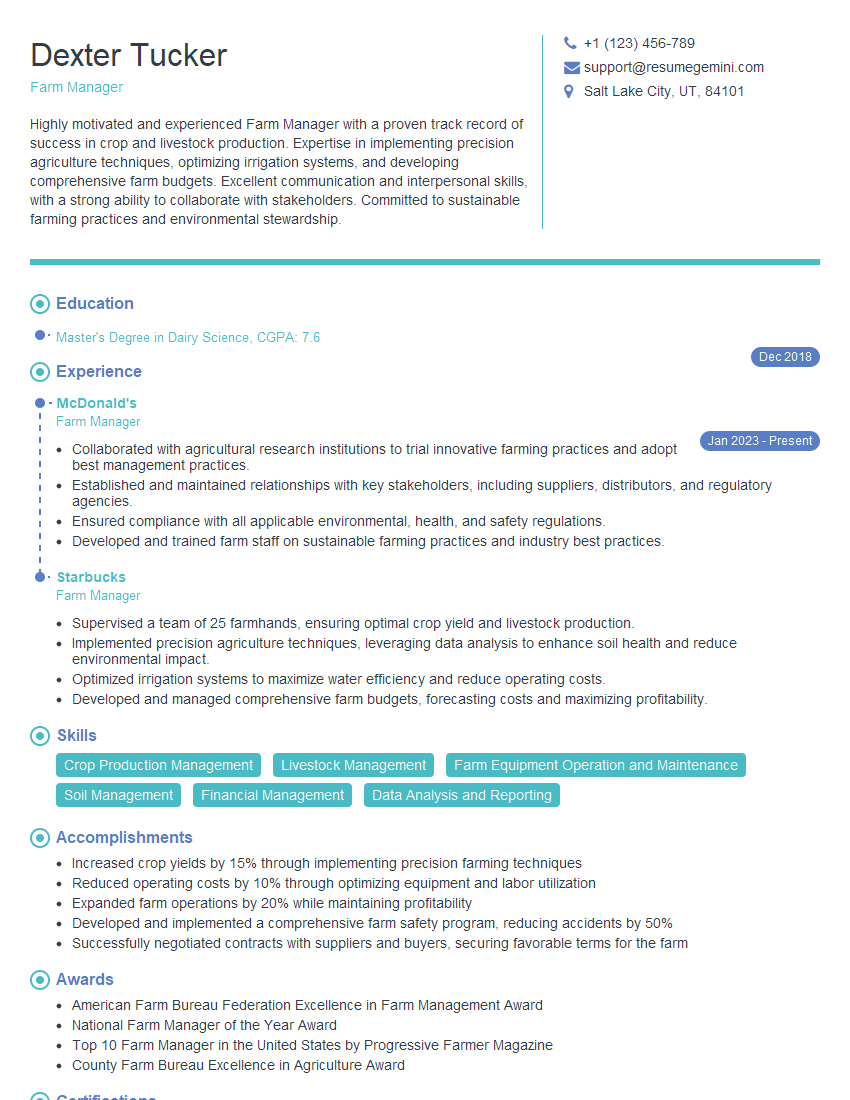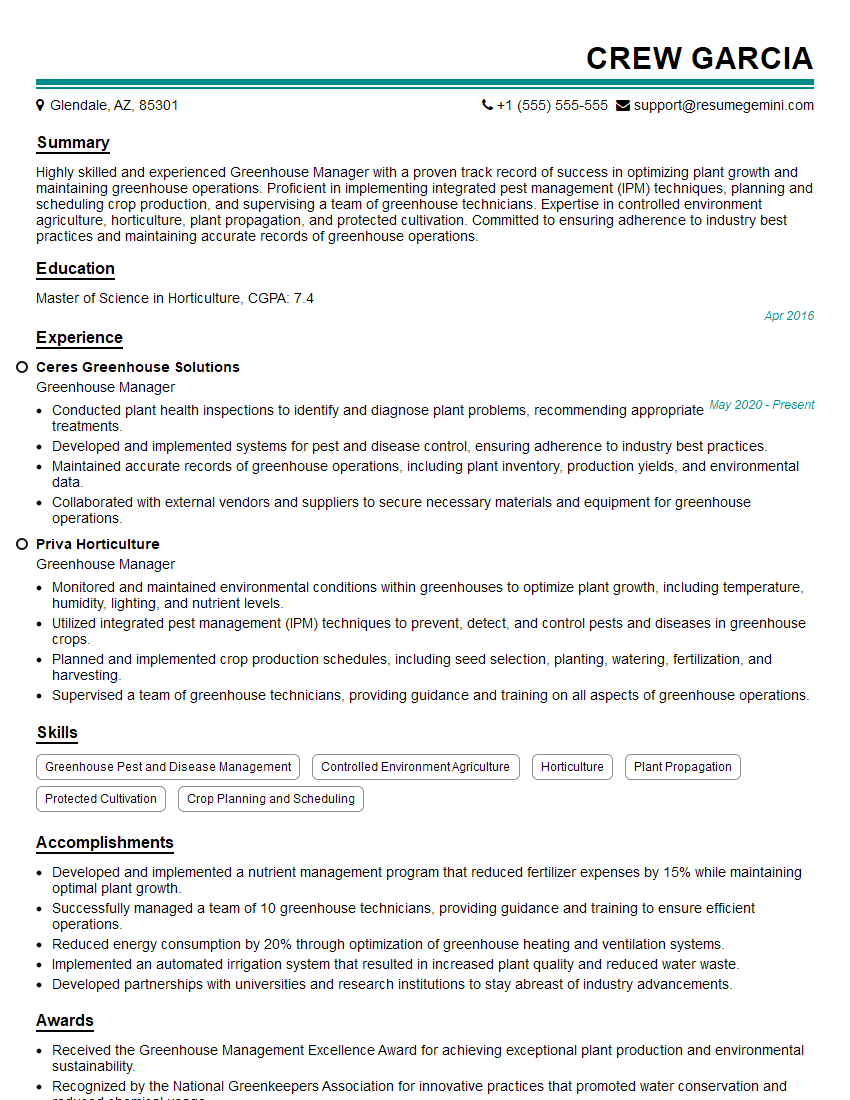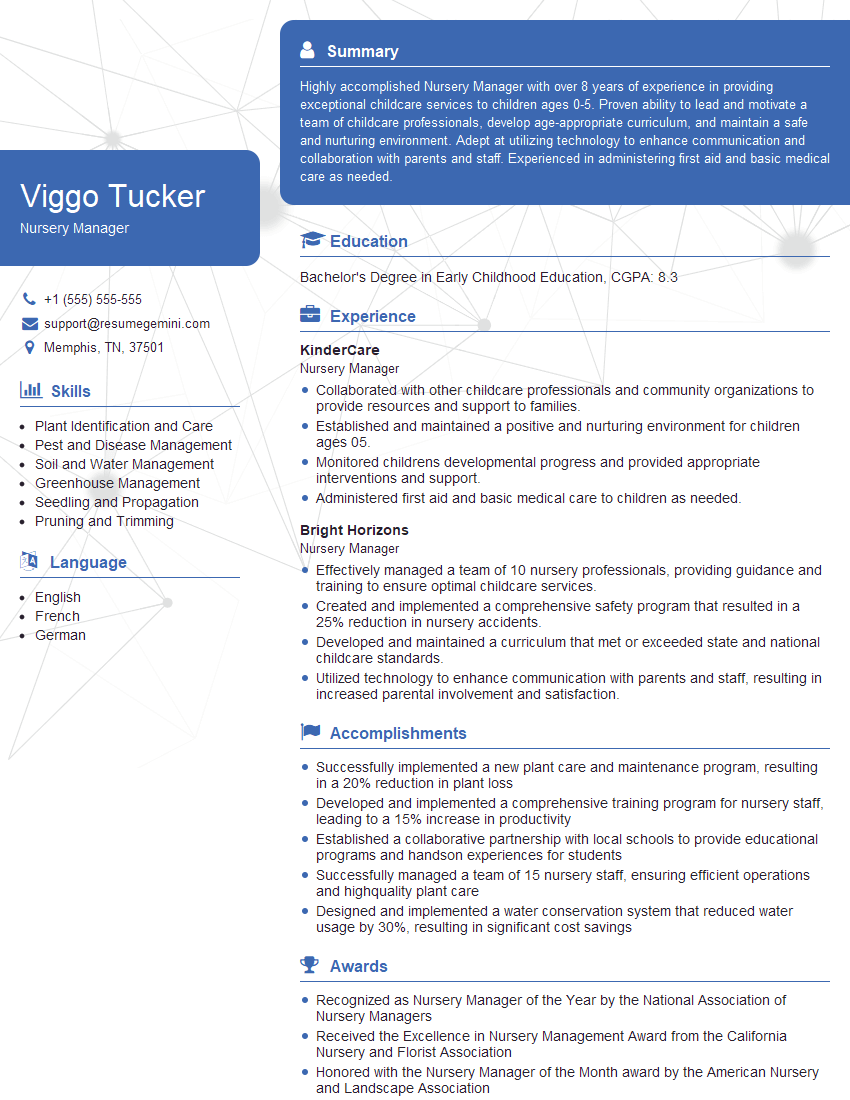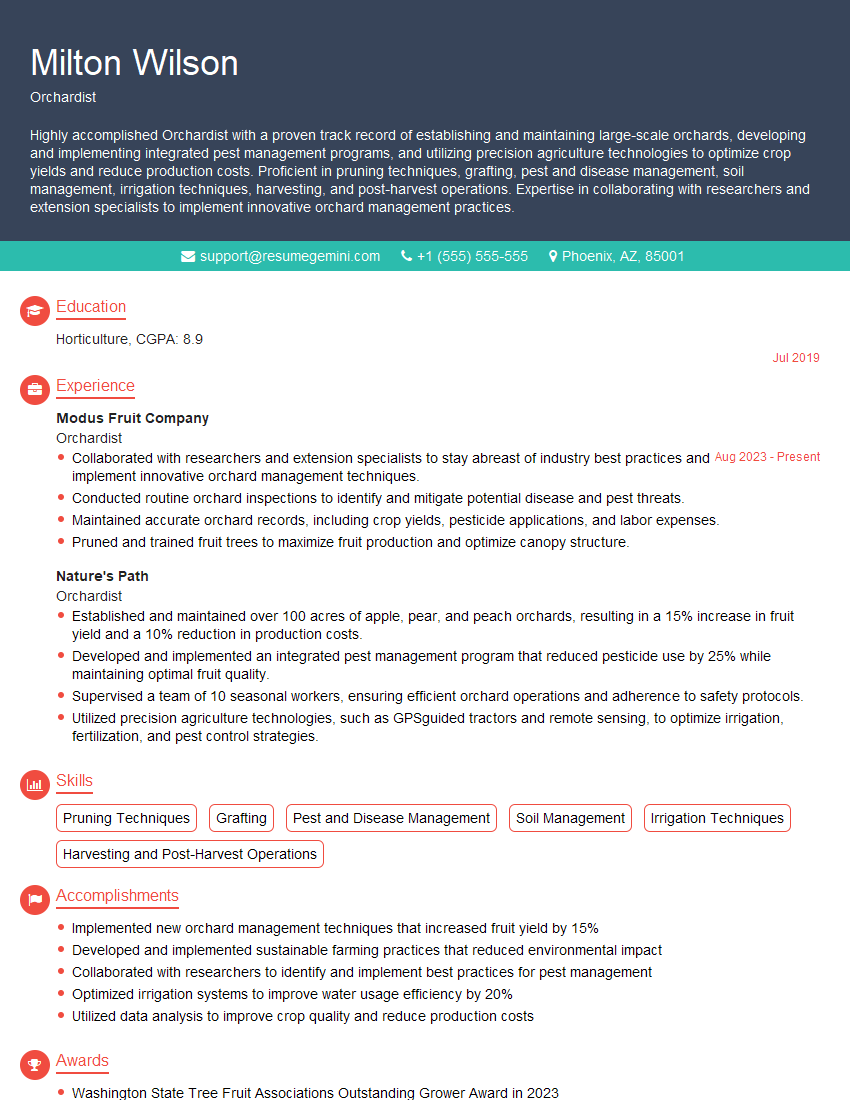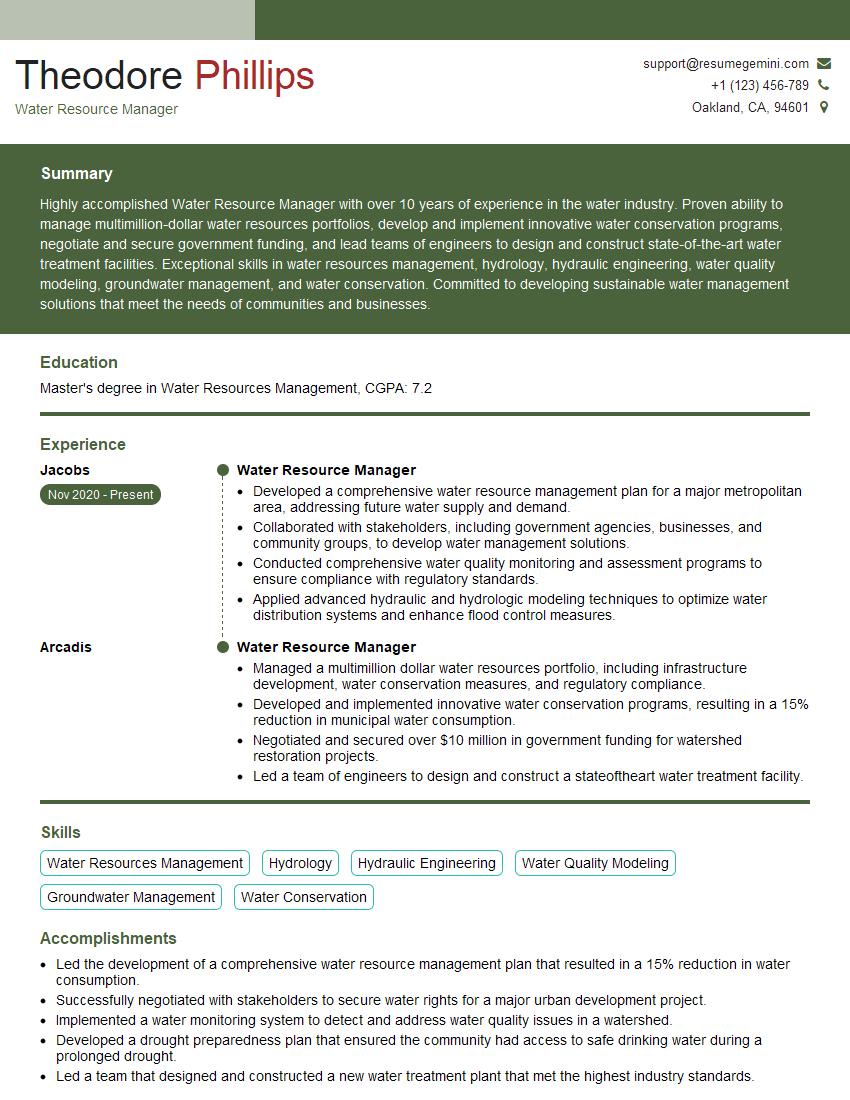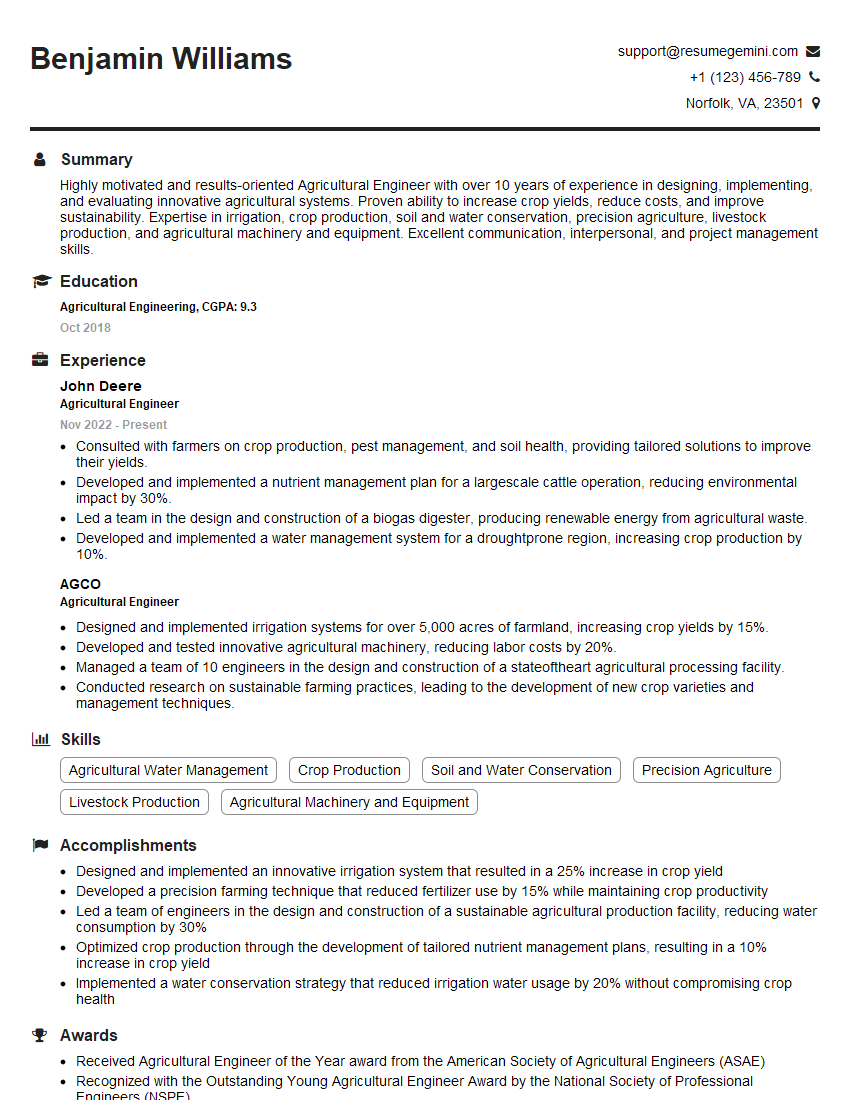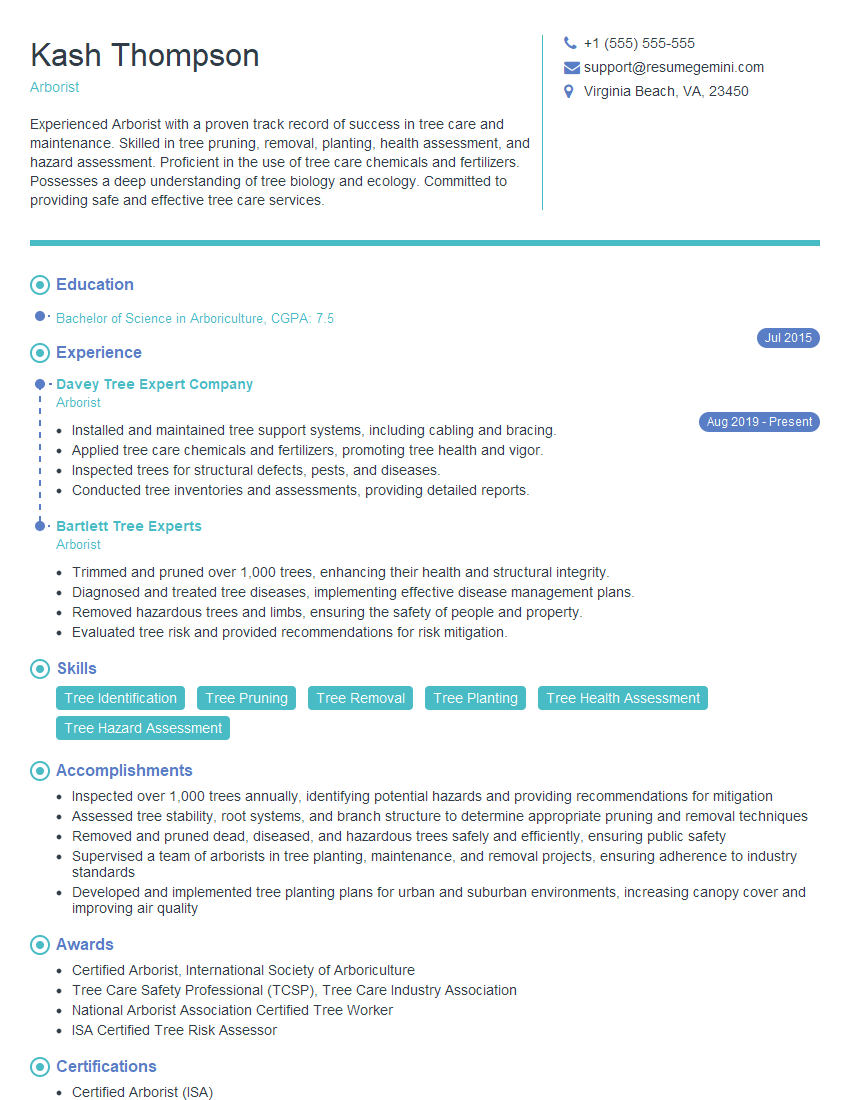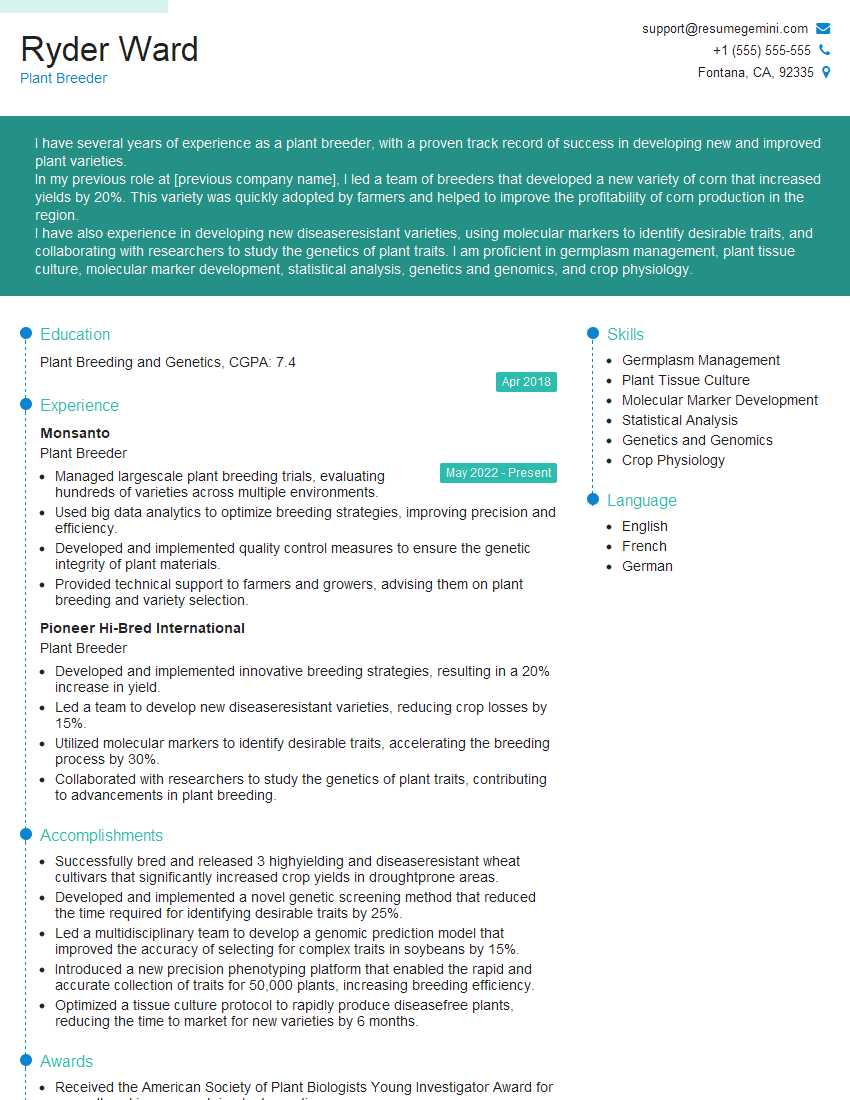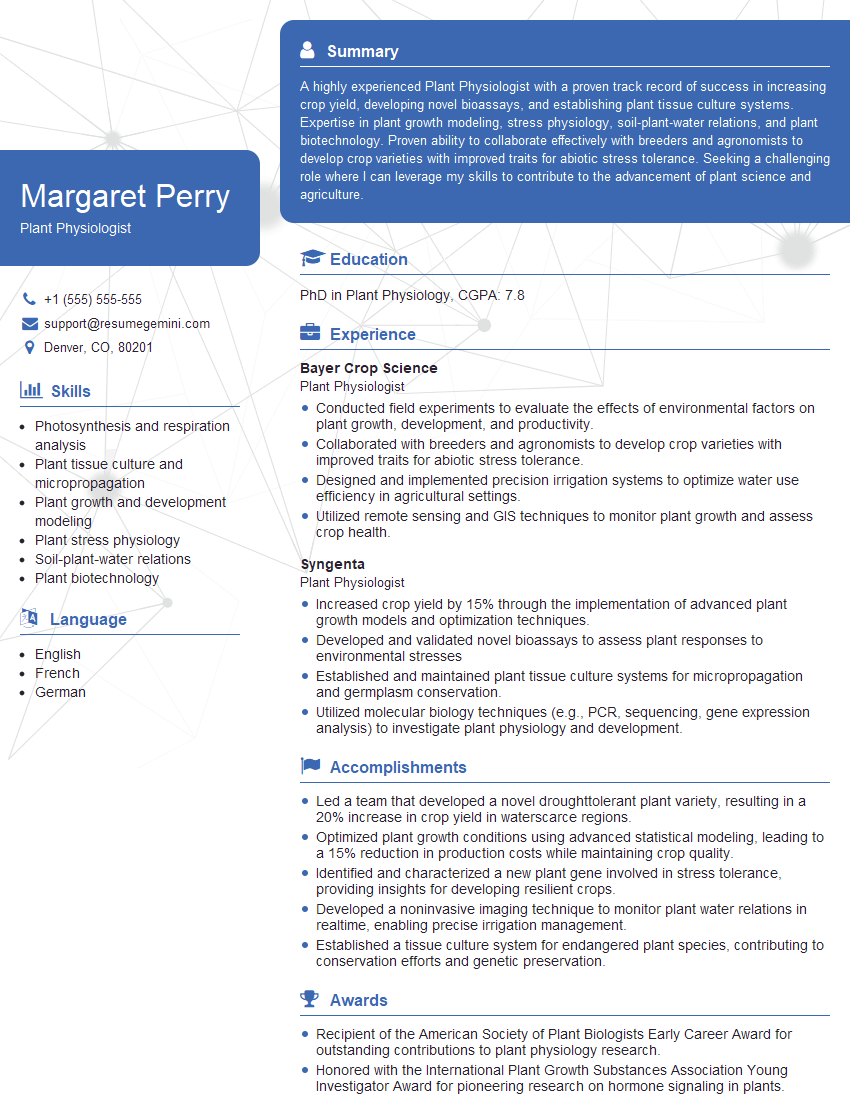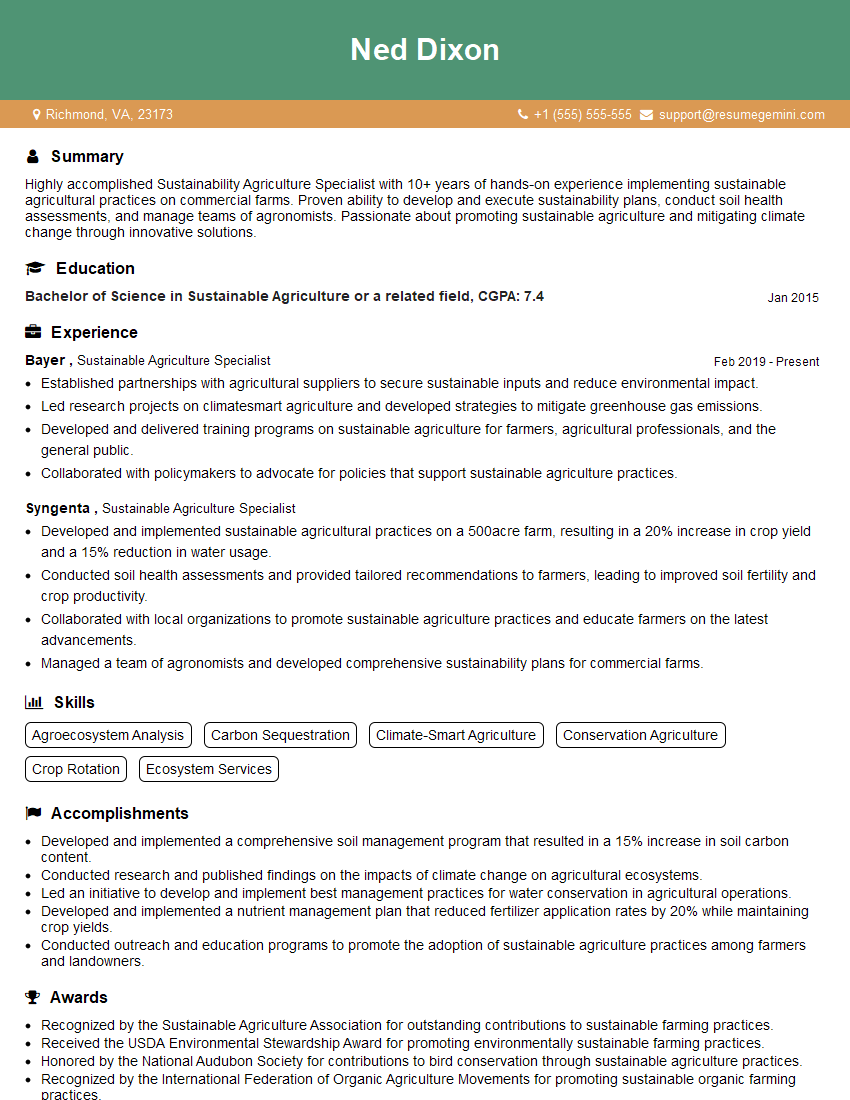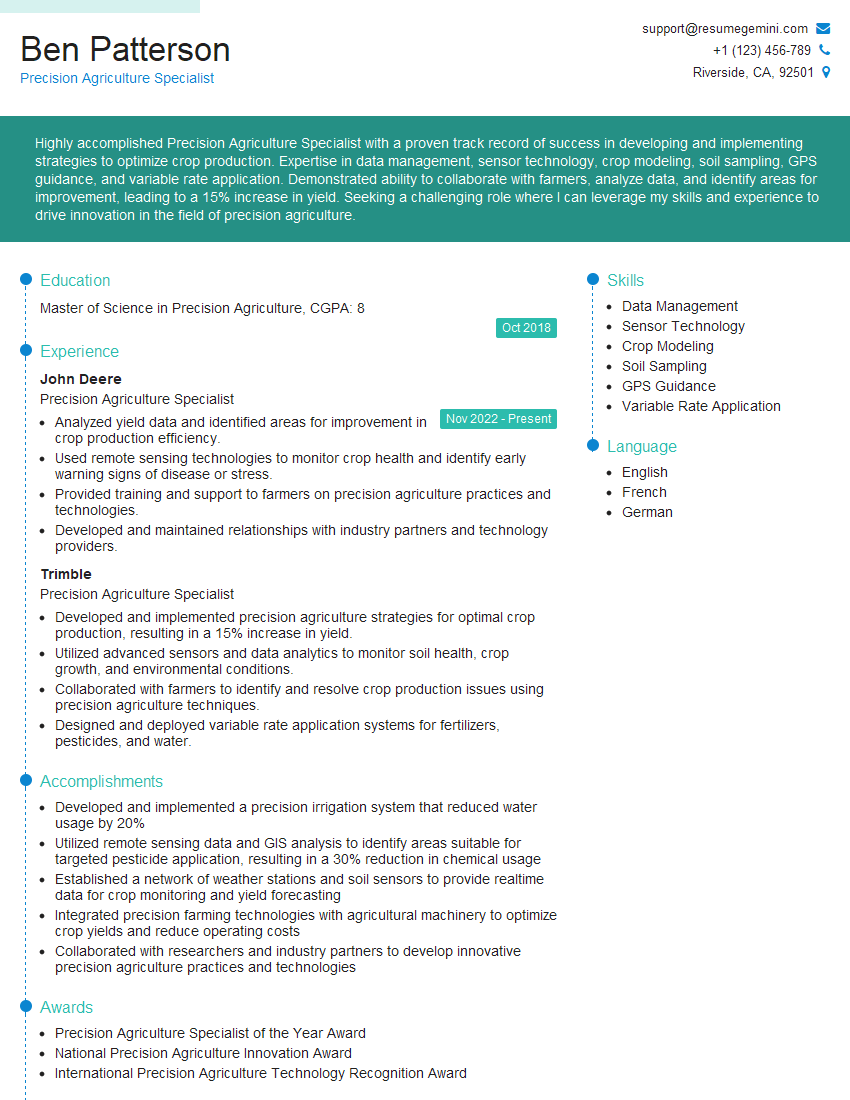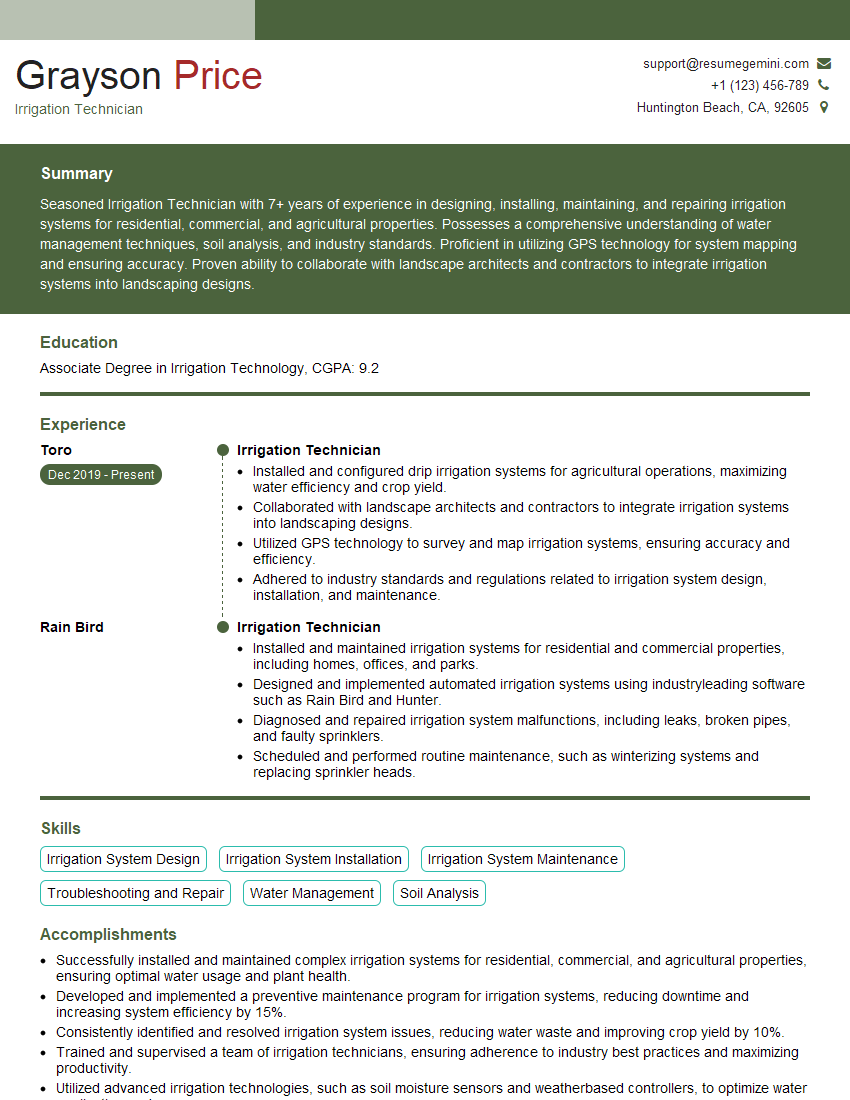Feeling uncertain about what to expect in your upcoming interview? We’ve got you covered! This blog highlights the most important Understanding of Plant Water Requirements interview questions and provides actionable advice to help you stand out as the ideal candidate. Let’s pave the way for your success.
Questions Asked in Understanding of Plant Water Requirements Interview
Q 1. Explain the concept of transpiration and its impact on plant water needs.
Transpiration is the process by which plants lose water vapor through tiny pores called stomata, located on the leaves. Think of it like plants ‘sweating.’ This process is crucial for several reasons: it helps pull water and nutrients from the roots to the rest of the plant (a process called the transpiration stream), it cools the plant down, and it also regulates the opening and closing of the stomata, impacting gas exchange (photosynthesis and respiration). The amount of water lost through transpiration significantly impacts a plant’s water needs. Higher transpiration rates, due to factors like high temperatures, wind, and low humidity, mean the plant needs more frequent watering.
For example, a leafy lettuce plant transpires much more rapidly than a succulent like a cactus, due to its larger leaf surface area and lack of water-storage adaptations. Therefore, lettuce requires much more frequent watering.
Q 2. Describe the factors that influence plant water requirements.
Plant water requirements are influenced by a complex interplay of factors. These can be broadly categorized into:
- Climate: Temperature, humidity, sunlight intensity, and wind speed all affect transpiration rates. Hot, sunny, windy conditions increase transpiration, leading to higher water needs.
- Plant Species: Different species have varying water requirements due to differences in leaf size, root systems, and physiological adaptations. A drought-tolerant species like a mesquite tree will require significantly less water than a water-loving rice plant.
- Soil Type: Soil texture and structure influence how well water is retained. Sandy soils drain quickly, requiring more frequent watering than clay soils, which retain water for longer periods.
- Growth Stage: Plants have higher water needs during periods of rapid growth, such as seedling establishment and flowering, compared to more mature stages.
- Plant Size: Larger plants, with a greater leaf area, generally need more water than smaller plants of the same species.
- Irrigation Method: The efficiency of the irrigation system itself plays a critical role. Drip irrigation, for example, is much more efficient than flood irrigation.
Q 3. How do you determine the appropriate irrigation scheduling for different plant species?
Appropriate irrigation scheduling involves understanding the specific water needs of each plant species and the prevailing environmental conditions. It’s not a one-size-fits-all approach. Several methods can help determine the schedule:
- Reference Evapotranspiration (ETo): This is a standardized measure of evapotranspiration from a reference crop (like grass) under specific conditions. This can be used as a starting point to estimate the water needs of other plants. Many weather stations provide ETo data.
- Crop Coefficients (Kc): These coefficients are plant-specific multipliers applied to ETo to determine the actual evapotranspiration (ETa) for a specific crop. These values are readily available from agricultural extension services or research publications.
- Soil Moisture Monitoring: Using soil moisture sensors to directly measure the water content in the root zone is a more precise way to determine irrigation timing. When the soil moisture reaches a pre-defined threshold, irrigation is triggered.
- Visual Inspection: Observing plant wilting or leaf drooping can indicate a need for irrigation, but this is a less reliable method as it often reflects severe water stress.
For instance, to schedule irrigation for tomatoes, you would obtain the ETo for your region, find the Kc for tomatoes (this varies by growth stage), calculate ETa (ETo * Kc), and then adjust this based on soil type and irrigation efficiency.
Q 4. What are the signs of overwatering and underwatering in plants?
Both overwatering and underwatering can severely damage plants. Recognizing the symptoms is crucial for timely intervention:
- Overwatering: Symptoms include yellowing leaves (chlorosis), leaf drop, stunted growth, root rot (roots become brown and mushy), and a foul odor from the soil. The soil remains consistently soggy and may even show standing water.
- Underwatering: Symptoms include wilting, leaf curling, dry and brittle leaves, browning leaf tips and edges, and stunted growth. The soil will feel dry to the touch, and the plant may be difficult to rehydrate.
It’s important to note that the severity and appearance of these symptoms can vary depending on the plant species and the duration of the stress.
Q 5. Explain different irrigation methods and their suitability for various crops.
Various irrigation methods exist, each with its own advantages and disadvantages:
- Drip Irrigation: Delivers water directly to the plant roots, minimizing water loss through evaporation and runoff. Excellent for various crops and efficient in water use. Suitable for orchards, vineyards, and high-value crops.
- Sprinkler Irrigation: Applies water overhead, mimicking rainfall. Relatively inexpensive to set up, but prone to water loss through evaporation and runoff, especially in windy conditions. Suitable for large fields of less water-sensitive crops.
- Flood Irrigation: Involves flooding the entire field with water. Least efficient method, high water loss, but simple to implement. Suitable only for very flat lands with low water requirements and specific crop types.
- Subsurface Drip Irrigation (SDI): Water is delivered through a network of tubes buried beneath the soil surface, reducing evaporation losses. Suitable for various crops in regions with high evaporation rates.
The choice of irrigation method depends on factors like crop type, water availability, land topography, and budget.
Q 6. How does soil type affect plant water uptake?
Soil type significantly impacts plant water uptake. The texture (proportion of sand, silt, and clay) and structure (arrangement of soil particles) determine the soil’s water holding capacity, drainage rate, and aeration.
- Sandy soils: Have large particles, allowing for rapid water drainage. Plants in sandy soils need more frequent watering because water is not retained for long.
- Clay soils: Have small particles, resulting in high water retention but poor drainage. This can lead to waterlogging and oxygen deficiency, affecting root growth and uptake.
- Loamy soils: A mixture of sand, silt, and clay, offering a good balance of water retention and drainage. These soils are generally ideal for plant growth.
The soil’s structure, such as the presence of aggregates and macropores, also influences water movement. Compacted soils restrict water infiltration and root penetration, hindering water uptake.
Q 7. What is soil water holding capacity and its importance in irrigation management?
Soil water holding capacity (SWC) refers to the maximum amount of water a soil can retain against the force of gravity. It is expressed as a percentage of the soil’s volume or weight. SWC is crucial for irrigation management because it determines how much water the soil can store and how often irrigation is required.
Knowing the SWC for a specific soil allows us to estimate irrigation amounts. If we know the SWC and the readily available water (the amount of water plants can easily access), we can calculate the amount of water needed to refill the soil to field capacity (the point where the soil is saturated but no more water drains). This information is essential for efficient irrigation scheduling and prevents overwatering or underwatering.
For example, a soil with a high SWC might require less frequent but deeper irrigations compared to a soil with a low SWC, which may need more frequent but lighter irrigations. Accurate determination of SWC necessitates soil testing, often conducted by agricultural extension services or soil laboratories.
Q 8. How do you measure soil moisture levels?
Measuring soil moisture involves determining the amount of water present in the soil. This is crucial for efficient irrigation, preventing both overwatering and underwatering. We can use several methods, each with its own strengths and weaknesses.
Gravimetric Method: This is the most accurate method. A soil sample is weighed, then dried in an oven until a constant weight is reached. The difference represents the water content. While precise, it’s time-consuming and only provides a snapshot of moisture at a specific point.
Volumetric Method: Similar to the gravimetric method but uses a known volume of soil. It offers a slightly less precise but faster assessment of soil moisture content.
Tensiometers: These instruments measure soil water tension, which is related to the soil moisture content. They provide a real-time measurement of how readily available water is to plants. They’re effective but have limitations in very dry or very wet soils.
Soil Moisture Sensors: These electronic devices use various technologies (capacitance, time-domain reflectometry (TDR), neutron probes) to measure soil moisture content. They are relatively quick and can provide continuous monitoring, though they can be expensive.
Simple Feel Test: A quick and rudimentary method involves feeling the soil. If the soil is dry and crumbly, it needs water; if it’s muddy and wet, it’s overwatered. This method is highly subjective and lacks precision.
The choice of method depends on the accuracy required, budget constraints, and the scale of the operation. For large-scale agriculture, sensors offer superior efficiency, while the gravimetric method might suffice for smaller, research-oriented settings.
Q 9. Explain the concept of evapotranspiration and its role in irrigation scheduling.
Evapotranspiration (ET) is the combined process of evaporation from the soil surface and transpiration from plants. It represents the total amount of water lost to the atmosphere from a given area. Accurate ET estimation is fundamental to irrigation scheduling, ensuring crops receive the right amount of water at the right time. Underwatering stresses plants and reduces yield, while overwatering leads to water waste, nutrient leaching, and potential disease.
Irrigation scheduling based on ET typically involves:
Estimating ET: Several methods exist, including using weather data (temperature, humidity, wind speed, solar radiation) in equations or employing ET models (e.g., Penman-Monteith). Some regions also provide ET maps.
Monitoring Soil Moisture: Using soil moisture sensors or tensiometers, we can determine when the soil’s water content reaches a critical level, triggering irrigation.
Considering Crop Water Requirements: Different crops have varying water needs throughout their growth cycle. This information, alongside the estimated ET, allows for precise irrigation scheduling.
Adjusting for Other Factors: Rainfall, runoff, and drainage should be accounted for in irrigation scheduling. If it rained heavily, less irrigation might be needed.
By accurately predicting and monitoring ET and soil moisture, we can optimize irrigation efficiency, conserving water and maximizing crop yields. For example, a farmer using ET-based scheduling might irrigate only when soil moisture drops below a predefined threshold, rather than following a fixed irrigation schedule, thus reducing water waste.
Q 10. Describe the different types of sensors used for monitoring soil moisture.
Various sensors are available for monitoring soil moisture, each with distinct advantages and disadvantages. The choice depends on factors like precision, cost, ease of use, and the specific application.
Capacitance Sensors: These measure the dielectric constant of the soil, which is related to the water content. They are relatively inexpensive, easy to install, and provide frequent readings. However, their accuracy can be affected by soil salinity and texture.
Time-Domain Reflectometry (TDR) Sensors: These use electromagnetic pulses to determine soil moisture. They are considered highly accurate, less sensitive to soil salinity, and can also measure soil temperature and electrical conductivity. However, they are usually more expensive than capacitance sensors.
Neutron Probes: These use a radioactive source to measure soil moisture. They are very accurate and can measure deep soil moisture profiles. However, they are expensive, require specialized training and licensing, and pose safety concerns due to the radioactive source. They are mainly used in research and large-scale monitoring.
Frequency-Domain Sensors: These measure the impedance of the soil, which is affected by soil moisture content. They are increasingly used due to their robustness and relatively low cost.
Each sensor type has specific installation requirements and calibration needs. Data from these sensors can be integrated into irrigation management systems for automated irrigation scheduling.
Q 11. What are the advantages and disadvantages of drip irrigation?
Drip irrigation, also known as micro-irrigation, delivers water directly to the plant roots through a network of tubes and emitters. It’s a highly efficient method, but like any system, it presents both benefits and drawbacks.
Advantages:
- High water use efficiency: Minimizes evaporation and runoff.
- Improved water distribution: Delivers water directly to the roots, reducing water stress.
- Reduced weed growth: Less water on the soil surface discourages weed germination.
- Nutrient delivery: Fertilizers can be directly applied through the drip system.
- Suitable for various terrains: Adaptable to slopes and uneven landscapes.
Disadvantages:
- Higher initial investment: Setting up a drip system can be more expensive than other methods.
- Potential for clogging: Emitters can become clogged with sediments, requiring regular maintenance.
- Uneven distribution: If not properly designed and maintained, some areas may receive insufficient water.
- Susceptible to damage: The tubing system can be damaged by rodents or physical impact.
- Not suitable for all crops: Not ideal for crops with large canopies or that require uniform water coverage.
Q 12. What are the advantages and disadvantages of sprinkler irrigation?
Sprinkler irrigation involves distributing water through a network of pipes and sprinklers that spray water over the crop. It’s a versatile method, but with both advantages and disadvantages.
Advantages:
- Relatively low initial cost: Simpler to install than drip irrigation.
- Good for large areas: Efficient for covering wide fields.
- Suitable for a variety of crops: Can be used for many different crop types.
- Easy to manage: Generally simpler to operate and maintain than drip irrigation.
- Can cool plants: Provides evaporative cooling, which is beneficial in hot climates.
Disadvantages:
- Lower water use efficiency: More evaporation and runoff compared to drip irrigation.
- Uneven water distribution: Can lead to overwatering in some areas and underwatering in others.
- Higher water demand: Requires more water than drip irrigation to achieve the same level of crop production.
- Increased weed growth: Water on soil surface encourages weed growth.
- Susceptible to wind and pressure variations: Spray pattern affected by wind conditions.
Q 13. How do you calculate the water requirements of a specific crop?
Calculating crop water requirements involves determining the amount of water a specific crop needs for optimal growth under given climatic conditions. It’s a complex process, and several methods exist, ranging from simple to sophisticated.
A common approach involves using crop coefficients (Kc) and evapotranspiration (ET):
Crop Water Requirement (CWR) = ET * Kc
Where:
ET (Evapotranspiration): This is the amount of water lost from the soil and plant surfaces to the atmosphere (explained previously).
Kc (Crop Coefficient): This is a dimensionless factor that represents the ratio of the crop’s evapotranspiration to the reference evapotranspiration (ETo). ETo is usually calculated for a reference crop (e.g., grass) and represents the potential evapotranspiration under ideal conditions. Kc values vary depending on the crop, growth stage, and environmental conditions. They are often found in agricultural handbooks or research publications.
The process involves:
- Estimating ETo using weather data or readily available regional data.
- Determining the Kc values for the specific crop at different growth stages.
- Calculating CWR using the formula.
- Adjusting for rainfall and other factors (irrigation efficiency, drainage, etc.).
More complex methods incorporate soil characteristics, plant physiology, and root-zone water extraction. Sophisticated software and models are available to assist in these complex calculations, making them readily accessible to farmers and agricultural professionals.
Q 14. Explain the role of mulching in water conservation.
Mulching involves covering the soil surface with a layer of organic or inorganic material. It plays a significant role in water conservation by modifying several soil properties and reducing water loss.
Reduced Evaporation: The mulch layer acts as a physical barrier, reducing direct sunlight on the soil surface and minimizing evaporation. This is especially effective in hot and windy climates.
Improved Soil Water Infiltration: Mulch helps improve soil structure, creating better channels for water infiltration. This reduces runoff and allows more water to reach plant roots.
Reduced Soil Temperature: Mulch moderates soil temperature, preventing rapid fluctuations that can affect water retention. Cooler soil holds water more effectively.
Reduced Weed Growth: By suppressing weed growth, mulching reduces competition for water and nutrients, ensuring more water availability for the intended crops.
Examples of mulching materials include straw, wood chips, plastic sheeting, and gravel. The choice of mulch depends on the specific climate, crop type, and soil conditions. In arid and semi-arid regions, mulching is a crucial technique for enhancing water use efficiency and supporting sustainable agriculture. It’s a simple yet powerful tool to reduce water consumption and improve crop yields, often leading to substantial cost savings for growers.
Q 15. How does climate affect plant water requirements?
Climate significantly impacts plant water requirements. Think of it like this: a marathon runner in a desert needs far more water than one in a humid forest. Temperature, humidity, wind speed, and sunlight all play crucial roles.
Temperature: Higher temperatures increase evaporation from plant leaves (transpiration), demanding more water intake. A hot, dry day leads to much higher water loss than a cool, cloudy one.
Humidity: High humidity reduces the transpiration rate, as the air is already saturated with water vapor. Lower humidity, conversely, increases the transpiration rate, leading to increased water needs.
Wind Speed: Wind accelerates the rate of transpiration by removing the humid air layer surrounding the plant leaves, creating a drier environment and stimulating higher water demand.
Sunlight: Intense sunlight increases leaf temperature and accelerates transpiration, requiring plants to absorb more water to maintain turgor pressure (the internal water pressure that keeps plants firm).
Understanding these climatic factors is vital for efficient irrigation scheduling. For instance, a farmer in Arizona needs to irrigate far more frequently than a farmer in Oregon, due to the drastically different climatic conditions.
Career Expert Tips:
- Ace those interviews! Prepare effectively by reviewing the Top 50 Most Common Interview Questions on ResumeGemini.
- Navigate your job search with confidence! Explore a wide range of Career Tips on ResumeGemini. Learn about common challenges and recommendations to overcome them.
- Craft the perfect resume! Master the Art of Resume Writing with ResumeGemini’s guide. Showcase your unique qualifications and achievements effectively.
- Don’t miss out on holiday savings! Build your dream resume with ResumeGemini’s ATS optimized templates.
Q 16. How do you address water stress in plants?
Addressing water stress in plants involves a multi-pronged approach focusing on prevention and mitigation. Early detection is key, as severe stress can lead to irreversible damage. Symptoms include wilting, leaf curling, reduced growth, and discoloration.
Improved Irrigation Techniques: Implementing efficient irrigation methods like drip irrigation or micro-sprinklers delivers water directly to the roots, minimizing evaporation and runoff. This ensures that the water is targeted and efficiently used by the plants.
Mulching: Applying mulch around the base of plants helps retain soil moisture by reducing evaporation. Think of it as a natural insulator for the soil.
Water-Wise Plant Selection: Choosing drought-tolerant plant species appropriate for the climate reduces the need for frequent irrigation.
Soil Management: Healthy soil with good structure and organic matter retention improves water infiltration and reduces runoff. Well-structured soil acts like a sponge, holding onto water for longer periods.
Supplemental Irrigation: Providing supplemental irrigation during periods of drought or high evapotranspiration rates is often necessary to prevent severe water stress.
For example, a farmer experiencing drought might employ a combination of mulching, deficit irrigation (discussed later), and the selection of drought-resistant crops to minimize the impacts of water stress on their yield.
Q 17. What is deficit irrigation, and when is it appropriate?
Deficit irrigation is a water management technique where plants are intentionally subjected to periods of water stress. It’s not about neglecting plants, but about strategically managing their water supply to optimize resource use and sometimes even enhance crop quality.
It’s appropriate when:
Water is scarce: In arid and semi-arid regions, deficit irrigation helps conserve water without significant yield reductions, particularly in drought-resistant crops.
Improving crop quality: Controlled water stress can enhance the concentration of certain desirable compounds in fruits, leading to improved flavor and nutritional value. For example, some studies indicate that mild water stress can improve the sugar content in tomatoes.
Reducing disease incidence: Well-managed deficit irrigation can lead to a reduction in soilborne diseases, as the drier soil conditions can limit pathogen development.
However, it’s crucial to carefully monitor plant responses and avoid excessive stress, which can drastically reduce yield and negatively impact plant health. The timing and severity of water deficit should be determined based on the plant species, growth stage, and climatic conditions.
Q 18. Describe different methods for improving water use efficiency in irrigation.
Improving water use efficiency in irrigation involves employing techniques that deliver water precisely where and when it’s needed, minimizing losses through evaporation, runoff, and deep percolation.
Drip Irrigation: Delivers water directly to the roots, reducing evaporation and runoff. It’s particularly effective for row crops and orchards.
Micro-sprinklers: Apply water in smaller droplets, reducing evaporation compared to traditional sprinkler systems.
Subsurface Irrigation: Delivers water below the soil surface, further minimizing evaporation losses.
Soil Moisture Sensors: Monitor soil water content and trigger irrigation only when necessary, preventing overwatering.
Weather-Based Irrigation Scheduling: Uses weather data (temperature, humidity, wind speed, solar radiation) to predict evapotranspiration rates and optimize irrigation schedules.
Water-Smart Technologies: Utilizing smart irrigation controllers with weather data integration and soil moisture sensors to automate irrigation and optimize water usage.
For example, a vineyard owner might choose drip irrigation to minimize water waste and focus water delivery on individual vines, maximizing fruit production with less water.
Q 19. What is the importance of water quality in irrigation?
Water quality is paramount in irrigation. Using water with excessive salts, pathogens, or chemicals can severely harm plant health and reduce yields. Think of it like feeding a plant with contaminated food – it won’t thrive.
Salinity: High salt concentrations in irrigation water can lead to soil salinity, reducing water uptake by plant roots and causing nutrient deficiencies. This can result in stunted growth and reduced yields.
Pathogens and Diseases: Contaminated water can introduce plant diseases and pathogens into the soil, causing significant crop losses.
Chemical Contamination: The presence of heavy metals, pesticides, or industrial effluents in irrigation water can be toxic to plants, leading to growth inhibition and potentially affecting the quality of the produce.
Regular water quality testing is essential for preventing irrigation-related problems. Farmers often analyze their water source for salinity, pH, and the presence of harmful substances. Addressing water quality issues may involve using filtration techniques, alternative water sources, or soil amendments to mitigate the negative effects.
Q 20. How do you manage salinity issues related to irrigation water?
Managing salinity issues in irrigation involves a combination of preventive and remedial measures. The goal is to prevent salt buildup in the soil while managing existing salinity problems.
Water Quality Monitoring: Regular testing of irrigation water for salinity is crucial. This helps in assessing the risk of salt accumulation and planning appropriate management strategies.
Efficient Irrigation Practices: Using efficient irrigation techniques like drip or subsurface irrigation minimizes the amount of water applied, reducing the risk of salt buildup. Efficient irrigation also helps prevent deep percolation, carrying salts deeper into the soil profile.
Leaching: Applying a sufficient amount of water to leach salts from the root zone is crucial. This process involves using excess water to flush out salts below the plant root zone. The amount of leaching required depends on soil type and salinity level.
Salt-Tolerant Plants: Selecting plant varieties that are tolerant to higher salinity levels can help reduce yield losses in saline soils.
Soil Amendments: Applying gypsum (calcium sulfate) can improve soil structure and help in the displacement of sodium ions (which contribute to salinity) with calcium ions.
For instance, in coastal areas with naturally saline water, farmers might utilize salt-tolerant crops and employ leaching practices to keep soil salinity at manageable levels.
Q 21. Explain the role of root systems in water uptake.
Root systems play a vital role in water uptake, acting as the plant’s water absorption organ. The vast network of roots, including the main roots, lateral roots, and root hairs, maximizes the surface area for contact with the soil water.
Root Hairs: These tiny extensions of root cells significantly increase the surface area for water absorption. They are responsible for the majority of water uptake in most plants.
Osmosis: Water moves from the soil into the roots through osmosis, a process driven by the difference in water potential between the soil and the root cells. Plant roots actively maintain a lower water potential inside their cells, drawing water from the surrounding soil.
Root Architecture: The architecture of the root system, including root depth and density, influences the ability of plants to access water from different soil layers. Deep root systems enable plants to access deeper water sources during drought conditions.
Mycorrhizae: Symbiotic associations between plant roots and fungi (mycorrhizae) can enhance water uptake by extending the reach of the root system and improving the access to water from the soil.
The efficiency of water uptake by the root system is impacted by various factors, including soil moisture, soil texture, soil temperature, and the presence of nutrients and salts in the soil. Understanding root system characteristics is vital for optimizing irrigation and water management practices. For example, a farmer might choose crops with deep root systems for arid regions where water is located at lower soil depths.
Q 22. How do you monitor the effectiveness of your irrigation system?
Monitoring irrigation system effectiveness involves a multi-pronged approach combining observation, measurement, and data analysis. We don’t just rely on assumptions; we actively track several key indicators.
Soil Moisture Monitoring: Using soil moisture sensors at various depths provides real-time data on water availability in the root zone. This helps determine if irrigation is delivering adequate water and if the timing is correct. For example, if the sensor readings show consistently high moisture levels after irrigation, we might need to adjust the frequency or duration of watering.
Plant Growth Monitoring: Regular visual inspections allow us to assess plant health and vigor. Signs of wilting, leaf discoloration, or stunted growth indicate potential water stress, even if soil moisture sensors indicate adequate moisture. This is crucial because soil sensors can sometimes be affected by various factors.
Water Use Efficiency Calculations: By tracking the volume of water applied and correlating it with plant growth and yield, we can calculate water use efficiency (WUE). A lower WUE suggests inefficiencies in the system requiring optimization. We might look at factors like leaks, inefficient sprinkler heads, or even poor soil drainage.
Yield Monitoring: Ultimately, the most important measure is yield. We carefully track the harvest to assess the overall impact of the irrigation system on the final product. Increased yield indicates effective irrigation management.
By combining these techniques, we can gain a comprehensive understanding of our irrigation system’s performance and identify areas for improvement. It’s a continual process of refinement based on data and observation.
Q 23. Describe the relationship between plant water status and plant growth.
Plant water status is intrinsically linked to plant growth. Think of it like this: water is the lifeblood of a plant. It’s essential for all metabolic processes, from photosynthesis to nutrient transport.
Optimal Water Status: When a plant has access to sufficient water, it maintains turgor pressure (the pressure exerted by water within cells). This turgidity keeps leaves erect, allowing for optimal sunlight capture for photosynthesis. Nutrients are transported efficiently, fueling growth and development.
Water Stress: Water deficit leads to reduced turgor pressure, causing wilting. This impairs photosynthesis and nutrient uptake, directly impacting growth. Severe or prolonged water stress can lead to permanent damage, reduced yields, and even plant death. For example, during a severe drought, I once saw a field of corn drastically reduced in yield due to water stress; the plants were stunted, with dry leaves and no ears developed.
Waterlogging: Conversely, excessive water can also harm plants by reducing oxygen availability in the root zone. This can lead to root rot and other diseases, further impacting plant growth and health. The roots need oxygen for respiration just like the above-ground parts need carbon dioxide.
Therefore, maintaining an optimal plant water status is critical for maximizing growth, yield, and overall plant health. It’s a delicate balance – avoiding both drought stress and waterlogging.
Q 24. What are the common problems associated with irrigation systems and their solutions?
Irrigation systems, while vital, are prone to several issues. Here are some common problems and their solutions:
Clogged Emitters/Nozzles: Mineral deposits or debris can clog emitters, reducing water flow. Regular cleaning or replacement is essential. We often use a low-pressure air flush to clear blockages.
Leaks: Leaks waste water and reduce system efficiency. Regular inspections, pressure testing, and prompt repairs are necessary. We use leak detection tools to pinpoint the location of leaks quickly and efficiently.
Uneven Water Distribution: This can result from faulty emitters, uneven terrain, or improper system design. Regular system calibration and potential modifications to the irrigation design might be required.
Low Water Pressure: Inadequate water pressure leads to insufficient water delivery. This can be due to pump failure, restricted pipes, or insufficient water supply. We might need to check and maintain the pump, clear pipe blockages, or even upgrade to a more powerful pump.
Overwatering/Underwatering: Improper programming of irrigation controllers can lead to these issues. Regular calibration and adjustment based on weather data and soil moisture monitoring are vital.
Preventive maintenance is crucial in minimizing these problems. A proactive approach saves time, water, and money in the long run.
Q 25. Explain how you would troubleshoot a malfunctioning irrigation system.
Troubleshooting a malfunctioning irrigation system involves a systematic approach. Here’s a step-by-step process:
Identify the Problem: Pinpoint the specific issue – is it a lack of water in a particular area, low pressure, or complete system failure?
Check the Obvious: Start with simple checks like checking the power supply, water source, and controller settings. Is the timer functioning correctly? Are there any visible leaks?
Inspect the Lines: Examine the pipes and lines for leaks, blockages, or damage. Sometimes, a simple blockage is the cause of a more significant-sounding problem.
Test the Emitters/Nozzles: Check each emitter or nozzle to ensure they are functioning correctly and distributing water evenly. If needed, replace clogged or damaged parts.
Check the Pump (if applicable): If the system uses a pump, inspect for any issues such as low power, mechanical failure, or insufficient water intake.
Consult Documentation/Schematics: Refer to the system’s design plans or manuals for guidance on troubleshooting. Diagrams help understand the system’s layout and identify potential points of failure.
Seek Expert Help (if needed): If you can’t resolve the issue yourself, contact a qualified irrigation technician. Sometimes a second pair of eyes is helpful.
By following this process, you can often diagnose and fix many common irrigation problems. Proper documentation of repairs is also crucial for future maintenance.
Q 26. How can you incorporate sustainable practices in irrigation management?
Sustainable irrigation practices focus on minimizing water waste while maximizing plant health and yields. Several strategies can be incorporated:
Water-Wise Landscaping: Selecting drought-tolerant plants reduces overall water needs. This is particularly effective in arid and semi-arid regions. We try to choose plants naturally adapted to the local climate.
Soil Moisture Sensors: Using sensors to monitor soil moisture allows for precise irrigation scheduling, avoiding both overwatering and underwatering.
Drip Irrigation/Micro-Irrigation: These methods deliver water directly to plant roots, minimizing evaporation and runoff. They are significantly more water-efficient than traditional sprinkler systems.
Rainwater Harvesting: Collecting rainwater for irrigation supplements the water supply and reduces reliance on municipal water sources. This can significantly reduce water bills.
Mulching: Applying mulch around plants helps retain soil moisture, reducing the frequency of irrigation. This also helps to maintain a consistent soil temperature.
Irrigation Scheduling Software: Software that utilizes weather data and soil moisture information to create optimized irrigation schedules improves water efficiency.
Implementing these practices not only conserves water but also reduces energy consumption and lowers operational costs. It’s a responsible and economically advantageous approach.
Q 27. Describe your experience with different irrigation controllers and their functionalities.
My experience encompasses various irrigation controllers, each with unique functionalities. For example:
Basic Time-Clock Controllers: These are simple, affordable controllers that operate on a pre-programmed schedule. While easy to use, they lack the flexibility to adjust to changing weather conditions.
Weather-Based Controllers: These controllers integrate with weather stations to automatically adjust irrigation schedules based on rainfall, temperature, and evapotranspiration rates. This is a significant improvement over simple time-clock systems, offering substantial water savings.
Smart Controllers: These advanced controllers often incorporate soil moisture sensors, allowing for even more precise irrigation scheduling based on real-time data. Some also incorporate remote monitoring and control capabilities, which is a significant advantage in large-scale irrigation systems.
Centralized Irrigation Management Systems: These systems control multiple controllers remotely through a central interface, allowing for comprehensive monitoring and management of large irrigation networks.
The choice of controller depends on the specific needs of the irrigation system and the budget. More sophisticated controllers offer greater control and water efficiency, but they also come with a higher cost.
Q 28. How do you adapt your irrigation practices based on weather forecasts?
Weather forecasts are crucial for adapting irrigation practices. I use weather forecasts in several ways:
Rainfall Prediction: If rain is predicted, I adjust or postpone irrigation schedules to avoid overwatering. Accurate forecasts allow for significant water savings.
Temperature Prediction: Higher temperatures increase evapotranspiration (water loss from plants and soil). I increase irrigation duration or frequency on hot days to compensate for increased water demand.
Wind Prediction: High winds increase evaporation, potentially requiring more frequent or longer irrigation cycles. We also need to consider the impact of wind on the distribution of water by sprinkler systems.
Evapotranspiration Estimates: Many weather services provide evapotranspiration (ET) estimates. ET data helps determine the amount of water plants need, enabling precise irrigation scheduling. This helps to balance the needs of the plants with water conservation.
By integrating weather forecasts into our irrigation management strategy, we can optimize water use, ensure adequate water supply for plants, and minimize water waste. This is crucial for both economic and environmental sustainability.
Key Topics to Learn for Understanding of Plant Water Requirements Interview
- Water Potential and its Components: Grasp the concept of water potential, including its components (pressure potential, osmotic potential, matric potential), and how they influence water movement in plants.
- Transpiration and its Regulation: Understand the process of transpiration, the factors affecting it (stomatal control, environmental conditions), and its role in water uptake and transport.
- Soil-Plant-Atmosphere Continuum (SPAC): Learn about the interconnectedness of soil water, plant roots, and the atmosphere, and how water moves through this continuum. Understand the resistances encountered along the pathway.
- Plant Water Stress and its Effects: Explore the physiological and morphological responses of plants to water stress, including wilting, stomatal closure, and osmotic adjustment.
- Irrigation Techniques and Water Management: Understand different irrigation methods (drip, sprinkler, flood) and their suitability for various crops and soil conditions. Explore strategies for efficient water use and conservation.
- Plant Water Use Efficiency (WUE): Define and explain the concept of WUE and how it is measured. Discuss factors affecting WUE and strategies to improve it.
- Practical Applications: Consider how this knowledge applies to real-world scenarios such as drought management, irrigation scheduling, and crop selection for specific climates.
- Problem-Solving: Practice analyzing scenarios involving plant water deficits, diagnosing water stress symptoms, and proposing solutions for improved water management.
Next Steps
Mastering the understanding of plant water requirements is crucial for career advancement in fields like agriculture, horticulture, and environmental science. A strong grasp of these concepts demonstrates valuable expertise and problem-solving skills highly sought after by employers. To significantly boost your job prospects, invest time in creating an ATS-friendly resume that effectively highlights your qualifications. ResumeGemini is a trusted resource that can help you build a professional and impactful resume tailored to your specific skills and experience. Examples of resumes tailored to showcasing expertise in Understanding of Plant Water Requirements are available through ResumeGemini, providing you with templates to guide your own resume creation.
Explore more articles
Users Rating of Our Blogs
Share Your Experience
We value your feedback! Please rate our content and share your thoughts (optional).
What Readers Say About Our Blog
Hello,
We found issues with your domain’s email setup that may be sending your messages to spam or blocking them completely. InboxShield Mini shows you how to fix it in minutes — no tech skills required.
Scan your domain now for details: https://inboxshield-mini.com/
— Adam @ InboxShield Mini
Reply STOP to unsubscribe
Hi, are you owner of interviewgemini.com? What if I told you I could help you find extra time in your schedule, reconnect with leads you didn’t even realize you missed, and bring in more “I want to work with you” conversations, without increasing your ad spend or hiring a full-time employee?
All with a flexible, budget-friendly service that could easily pay for itself. Sounds good?
Would it be nice to jump on a quick 10-minute call so I can show you exactly how we make this work?
Best,
Hapei
Marketing Director
Hey, I know you’re the owner of interviewgemini.com. I’ll be quick.
Fundraising for your business is tough and time-consuming. We make it easier by guaranteeing two private investor meetings each month, for six months. No demos, no pitch events – just direct introductions to active investors matched to your startup.
If youR17;re raising, this could help you build real momentum. Want me to send more info?
Hi, I represent an SEO company that specialises in getting you AI citations and higher rankings on Google. I’d like to offer you a 100% free SEO audit for your website. Would you be interested?
Hi, I represent an SEO company that specialises in getting you AI citations and higher rankings on Google. I’d like to offer you a 100% free SEO audit for your website. Would you be interested?
good
